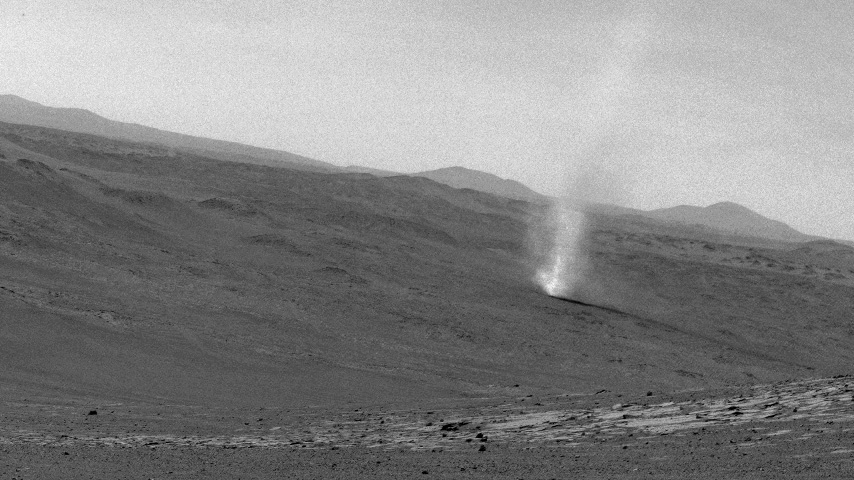The most recent spacecraft telemetry was acquired on Dec. 13 from the Deep Space Network tracking complex at Canberra, Australia. The Cassini spacecraft is in an excellent state of health and with the exception of the CAPS instrument being powered off, all subsystems are operating normally. Information on the present position and speed of the Cassini spacecraft may be found on the "Present Position" page at: http://saturn.jpl.nasa.gov/mission/presentposition/.
Wednesday, Dec. 7 (DOY 341)
This week’s science observations included two observations in the Titan monitoring campaign performed by the Imaging Science Subsystem (ISS), Composite Infrared Spectrometer (CIRS), and the Visual and Infrared Mapping Spectrometer (VIMS). ISS made astrometric observations of some of Saturn's smaller moons including Helene and Telesto, along with three sets of mutual event observations - the transit of Rhea across Dione, the transit of Dione across Titan, and the transit of Tethys across Titan. Later, the Cosmic Dust Analyzer (CDA) performed a 14.5 hour interstellar dust observation, and CIRS performed a 12 hour observation of Saturn in order to measure oxygen compounds (H2O, CO2) in the stratosphere. The Ultraviolet Imaging Spectrograph (UVIS) made an observation of the star Spica for calibration purposes, then ISS observed Titan for a double mutual event opportunity - a transit of Titan across Tethys followed by transit of Rhea across Titan, and to make measurements of Titan's atmospheric haze layer. UVIS made repeated slow slews across Saturn's auroral zone, monitoring the Enceladus footprint. CDA took measurements of the E ring during the ring shadow crossing at 4 Rs.
Friday, Dec. 9 (DOY 343)
Orbit Trim Maneuver (OTM) #301 was performed today. This was an approach maneuver setting up for the Dione 3/Titan 79 encounters on Dec. 12 and 13. The Reaction Control Subsystem (RCS) burn began at 2:14 PM PST. Telemetry immediately after the maneuver showed a burn duration of 11.25 seconds, giving a delta-V of 0.018 m/s. All subsystems reported normal performance after the maneuver.
Many Cassini scientists attended the American Geophysical Union meeting in San Francisco Dec 5-9, where numerous sessions highlighted Cassini science results.
A telecon was held today with personnel from the NASA Engineering and Safety Center and the Southwest Research Institute who are working to better understand the nature of the electrical problems with CAPS and the spacecraft. Progress is being made on the problem, but a final decision on turning the instrument back on is still some time off.
Saturday, Dec. 10 (DOY 344)
The next maneuver, OTM-303, is scheduled to execute on December 17, and is the cleanup maneuver following the Dione 3/Titan 79 flybys. OTM-304 follows on December 22, targeting to the Titan 80 encounter.
Monday, Dec. 12 (DOY 346)
Cassini encountered Dione today at an altitude of 99 kilometers and a speed of 8.7 km/sec to examine the moon’s internal structure. The design of this close encounter also provided the ion and neutral mass spectrometer (INMS) a good sample opportunity, and before closest approach there was also time for the optical remote sensing (ORS) instruments to observe Enceladus from a relatively near distance. For more information on this subject link to: http://saturn.jpl.nasa.gov/mission/flybys/dione20111212/.
Today the Cassini Radio Science (RSS) Team completed the S71 Rev 158 Dione (D-3) gravity observation. D-3 is the first Dione flyby with tracking at closest approach. In spite of the relatively small mass of the satellite, the spacecraft acceleration will be clearly detected in the Doppler data. The accuracy of range rate measurements provides good sensitivity not only to the monopole, but also to the quadrupole field, which will be determined for the first time. The observation consisted of three segments (inbound, closest approach, and outbound), and was covered by Beam Wave Guide (BWG) antennae at all three complexes starting with Canberra’s DSS-34, followed by Madrid's DSS-55, and ending with Goldstone's DSS-25. The radio science measurements will add insight into how highly structured the interior of the small moon is, which in turn should provide clues about its recent history and possible activity.
The Instrument Operations System/Multi Mission Image Processing Laboratory (IOS/MIPL) expedited processing for the Dione 3 flyby, delivering images to the science team and raw image website during the downlink.
The main engine cover was closed on Dec. 10 prior to the dust crossing for dust hazard avoidance and was opened today. This was the 70th in-flight cycle of the cover.
Non-targeted flybys of Calypso, Enceladus, and Tethys occurred today.
Tuesday, Dec. 13 (DOY 347)
Cassini encountered Titan at an altitude of 3,586 kilometers and a speed of 5.8 km/sec today. The composite infrared spectrometer (CIRS) was prime during the Titan flyby, about 36 hours after the Dione encounter. This flyby was originally planned to be a Cassini Plasma Spectrometer (CAPS) flyby, but was switched to an Optical Remote Sensing flyby since CAPS was powered off in June due to a power bus short. For more information on the Titan flyby, link to: http://saturn.jpl.nasa.gov/mission/flybys/titan20111213/.


































